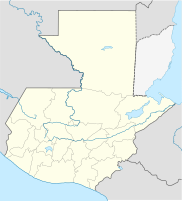El Estor
| El Estor | ||
|---|---|---|
|
Coordinates: 15 ° 32 ' N , 89 ° 21' W El Estor on the map of Guatemala
|
||
| Basic data | ||
| Country | Guatemala | |
| Department | Izabal | |
| City foundation | 1871 | |
| Residents | 42,984 (2002) | |
| Detailed data | ||
| surface | 2896 km 2 | |
| Population density | 15 people / km 2 | |
| height | 45 m | |
| Waters | Izabal lake | |
| Post Code | 18003 | |
| Time zone | UTC −6 | |
| City patron | San Pedro | |
El Estor is a small town in eastern Guatemala . It is the administrative seat of the large municipality of the same name ( Municipio ) in the department of Izabal . Over 50,000 people live in the 2,896 km² municipality.
geography
El Estor is located on the northwestern shore of Lake Izabal , at the foot of the Sierra de Santa Cruz, which is up to 1,200 meters high. The municipality comprises the western part of the Izabal department. In the northwest the area of the neighboring municipality Livingston extends , in the southwest Izabal borders the municipality Los Amates , as well as the department Zacapa and, in the west, Alta Verapaz . In addition to parts of the Sierra de Santa Cruz in the north and northwest and the foothills of the Sierra de las Minas in the southwest, the municipality of El Estor also includes the estuary of the Río Polochic in the alluvial plain on the western shore of the lake, which has been placed under nature protection ( Bocas de Polochic ) . In the 23,000 hectare nature reserve there are numerous species of birds and fish, including crocodiles and jaguars . The climate on the shores of the lake and in the western lowlands is tropical, and somewhat more moderate in the mountain regions.
history
Since Lake Izabal is connected to the Caribbean via the navigable Río Dulce , several places on the lake have long served as storage and transshipment points for trade between the highlands of Guatemala and North America and Europe, including El Estor. At the end of the 19th century, the Englishman George Skinner and the German Carl Rudolf Klee ran a general store here called The Store , but the locals soon turned it into El Estor . The original Kekchí name was Sekel , which roughly means "grinding woman". It refers to the many women who ground corn here and baked tortillas with it .
population
In the municipality of El Estor mainly Kekchí live .
Economy and Transport
El Estor previously served as a secondary trading post for Alta Verapaz and for a long time was overshadowed by Panzós , which lies further west on the Río Polochic and had an inland port and a railway connection. The situation has improved somewhat after the construction of National Road 7, which connects El Estor with Alta Verapaz in the west and the CA 13 road near El Relleno in the east. Private providers of charter boats ensure transport on the lake. These transport links have given tourism a limited boom. The textile trade is also important. The mining of nickel and cobalt stopped a few years ago.
